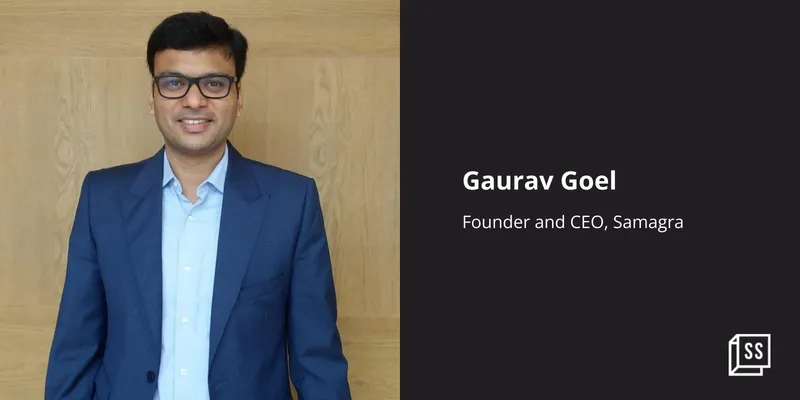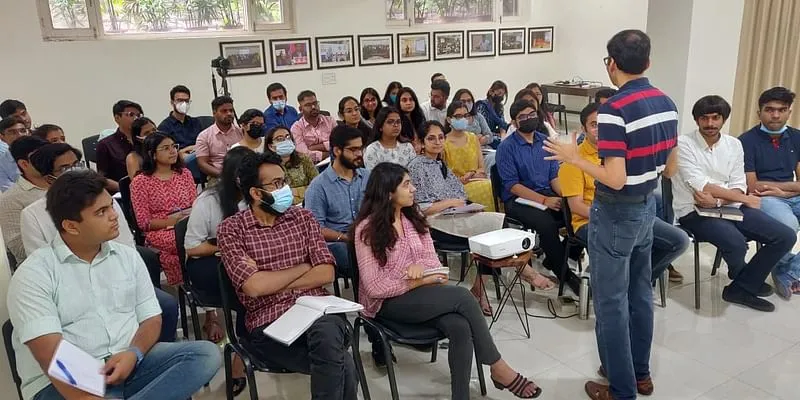How this governance consulting firm is driving change in governments across India
Delhi-based govtech firm Samagra works with the bureaucratic leadership of states across domains to solve complex governance problems at scale.
In India, governance works as a lever of change. Gaurav Goel, an ex-McKinsey employee, realised this and started a governance consulting firm Samagra in 2012 using his own savings.
The vision was to drive change at a grassroots level by engaging with the governance process. The firm believes that by working outside the system, one might be able to create islands of excellence, but to change the lives of millions for the better, it is necessary to engage with the governance process.
Samagra combines management consulting with a comprehensive understanding of grassroots realities to implement tech and data-backed solutions.
Gaurav, Founder and CEO of Samagra, tells SocialStory,
“We work on system reforms that build the state’s capacity to achieve sustainable outcomes at scale in a particular domain. We come in the early stages, identify a tangible goal, create a road map, and work with the government till measurable outcomes are achieved.”

How this social enterprise is helping the Odisha govt boost agricultural productivity in the State
Approach and overview
Samagra’s consulting methodology blends a top-down management approach for problem structuring, with a bottom-up knowledge of using governance for system implementation.
The firm’s programmes offer long-term systemic transformation rather than point interventions. The first wave of a programme is typically two to three years long, and increases in duration as the scope expands.
Gaurav believes that funding is more of an obligation once exercised, and wanted to build the firm on the lines of Atmanirbhar Bharat.
“For financial assistance, we put the onus on the government to figure out a philanthropic source of funding for our team for that piece of work,” Gaurav adds.
Although Samagra is an 80-member consulting team, it sends five-member dedicated teams, including leadership and tech members, to state capitals and other areas where the work is needed.
Gaurav says that one of the key challenges that his team faces while working with the government administration is the frequent transfers of the bureaucrats, given that each of Samgra’s projects takes several months to years to implement.
Key projects
Headquartered in Delhi, Samagra so far has worked with six state governments (Haryana, Himachal Pradesh, Uttar Pradesh, Odisha, Andhra Pradesh, and Delhi), in addition to the Government of India, on 15+ large-scale systemic transformation programmes across domains such as education, employment, agriculture, health, public service delivery, and skilling.
In Haryana, the team launched Antyodaya Saral to address the fundamental challenges in public service delivery. Under Antyodaya Saral, Samagra implanted key efficiency criteria in the government service delivery ecosystem—streamlined process, faster processing, transparency and tracking, online payments, grievances handling, and feedback and active communication from the service provider.
One of the key projects in Uttar Pradesh was Mission Prerna. The vision here is to impart foundational literacy and numeracy to 1.4 crore primary grade government students in the next four years. For this, the company developed the Prerna Lakshya App in collaboration with Google. The app can be used by parents and teachers to assess students and also help them practice weaker competencies.
Launched in 2017, Saksham Haryana is another project working in the field of education. Recently, Samagra worked with the government of Haryana to facilitate remote learning for government school students through the e-Adhigam scheme. Under this, the government is distributing five lakh free tablets to students of classes 11 and 12 in the forthcoming academic session.
The govtech startup also works in the fields of skills and employment under Saksham Haryana. It streamlines and makes government recruitment for Group C and D jobs transparent.
“We are designing and implementing a dual system of training, or DST, which allows students at industrial training institutes to get on-the-job training as part of their curriculum, thereby making them more job-ready and employable,” Gaurav explains.
He further adds that since Saksham Haryana’s launched, the state has had the highest number of apprentices appointed per lakh population. In 2017, the number of apprentices per lakh population was 87; in 2018 it rose to 233; and at the beginning of 2020, this number had reached 420.
The majority of central government ministries have yet to take even the most basic measures toward embracing technology. This is one of the most critical gaps Gaurav has been solving with Samagra X. Taking a govtech approach, the idea of the organisation is to build reusable, scalable, extensible, and deployable technology products using OpenSource tools.
Samiksha is an open source product designed to improve school quality control activities conducted by education department officials in government schools. It consists of a mobile application, an application control console, and a set of review dashboards. Since July 2019, Samiksha has been used by state education department of Haryana in nearly 30,000 government schools with over 14,000 active government users.

Samagra was set up in 2012 as a mission-driven governance consulting firm
This civic-tech startup is addressing problems of rural population with technology
Promoting young talent
Along with its key initiatives across states, Samagra is also cultivating talent at the grassroots level with The Governance Challenge (TGC) and Code for GovTech (C4GT).
TGC, a national governance case competition has been rolled out for 25 premier business schools and public policy schools in the country. The top three teams will win cash prizes worth Rs 9 lakh along with individual pre-placement interview (PPI) opportunities with Samagra.
C4GT is an open source govtech mentoring programme for engineering students through a summer coding programme started in May and ended in August 2022. The shortlisted contributors will receive a stipend and a job opportunity with prominent govtech companies.
“For the past five years, we have been working on crafting that value proposition for young talent such that they are attracted towards us and the social service sector. This is an opportunity for students to contribute to actively evolving digital public goods that impact millions and a chance to start a high-impact career in prominent govtech companies. This is one theme that is big on our head,” Gaurav adds.
(This article was updated to correct a factual error.)
Edited by Kanishk Singh






